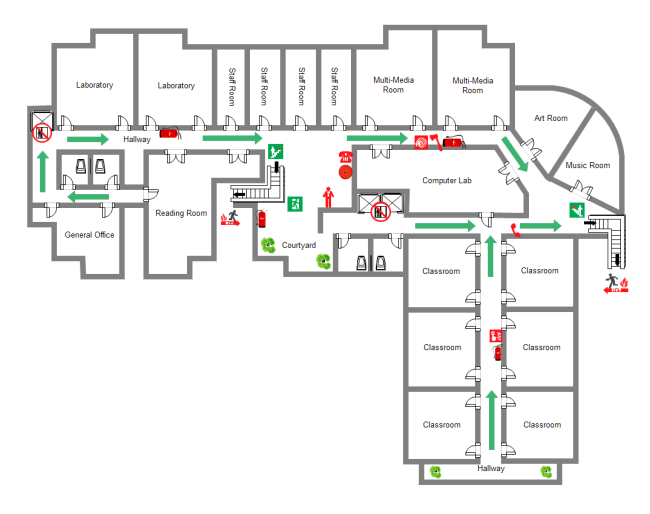After a far longer break than planned, EverydayMFL is back. Prior to this hiatus, I had worked my way through a number of the less desirable GCSE topics to teach. After going through global issues, customs and festivals and charity and volunteering. I decided school and study should be next. Kids have mixed feelings about the topic. Teachers might also have mixed feelings. It comes with some nice easy grammar in Year 7 but then it is less fun to talk about in Year 11.
Here are a few ways to make the school topic fun.
Who’s the greatest?
Flowcharts are used heavily in other subjects but rarely in languages. I’ve often used one set out as follows to allow students to give their opinions on the best teacher. It is also great CPD as you can find out the one they genuinely believe to be the best and then learn from them. Quite often the one described as a “legend” is different from the one they feel they learn best from.
Opinion phrase
Teacher
is the most …
because (positive reasons) because (negative reasons)
although he/she can be
positive adjectives negative adjectives
You could achieve a similar effect with a writing frame but I think the flowchart gives a slightly different feeling of progression.
At the end you could get them to apply it to a different topic. Whilst the phrasing is slightly artificial, it should show the students that the same structure can be applied across topics.
I think that <insert sport here> is the most … because … although it can be …
Hogwarts Conditional

The majority of students still appreciate the Harry Potter books. This allows you to teach conditional clauses: “if I went to Hogwarts, I would study …” “If I were at Hogwarts, my favourite teacher would be…”
List of subjects here if you need them.
Alternatively …
If I were the boss

Again teaching conditional clauses, you would be surprised how many students want to talk when they are given a writing frame on school improvement.
“If I were the head, I would…”
“If I had the choice, I would…”
“If I could, I would…”
Clause structures & Descriptions
Early in year 7 students are likely to have learnt how to describe people. It is often worth revisiting in year 10-11 but I have tried to do it with more advanced clause structures:
- Not only…but also
- Both … and …
- Neither … nor
- Regardless of whether … is …, I think that …
- He/she can be … but can also be …
- In spite of being … , he/she is also …
Germanists can have a field day here with “weder…noch…”, “egal, ob…”, “zwar…aber…” and “sowohl…als auch”. I’m sure French and Spanish teachers can come up with a few.
Describing your school

This has got to be one of the most tedious bits to teach. I cannot imagine many students enjoy relating the facts that their school has classrooms, modern science labs and a small playground. Here is an activity to make it ever so slightly more interesting:
Teacher gives half of the class mini-whiteboards. The other half are given cards containing a description of a school (parallel text in both languages). Starting in the top corner students draw in the rooms as they are told where they are. The whiteboard is then passed to the other person to check. They then rub out any wrong rooms and read those parts again.
You will need two sets of descriptions so that both people can have a go.
This could also be done as a whole class listening task. You could even do the school you are in and get students to spot the mistakes you make.
After School Clubs

Again, another topic to enthuse…
Essentially from this you want students to come away with a structure such as: “después del instituto”, “después de haber terminado mis clases”, “après avoir fini mes cours”, “am Ende des Tages” combined with the preterite/passé composé or perfekt tense
Have students look up some slightly more interesting activities in advance of this lesson. Fencing, bungee jumping, quidditch, gaming. They can then practice the structure you want them to learn. I can imagine some quite creative efforts once you add in TMP (Germanists only).
Future plans Cluedo

ah…the good old days
I was introduced to “who killed Santa” cluedo in my NQT year by two super language teachers I worked with. The structure can largely be applied to anything. Another popular language teaching website calls it mind-reading.
Give students the following table on a slide.
They pick three phrases and write them on a mini-whiteboard or in books. The student guessing needs to read out the verbs at the top and the infinitives. The person with the three answers can only tell them how many they are getting right.
| I want to… | I’m going to… | I would like to |
|---|---|---|
| infinitive chunk infinitive chunk infinitive chunk infinitive chunk |
infinitive chunk infinitive chunk infinitive chunk infinitive chunk |
infi YOU nitive infi GET nitive infi THE nitive infi IDEA nitive |
This is great as you can recycle quite a lot of language and also three ways of talking about the future at once.











